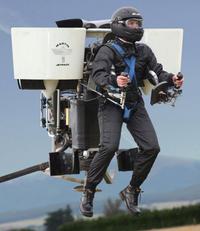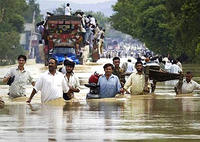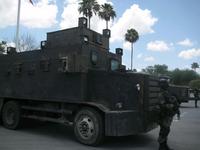-
Emergency responders could have jetpacks by year's end

Emergency responders in New Zealand could soon be zipping around on personal jetpack; last month, Glenn Martin, an inventor based in New Zealand, successfully flew his jetpack up to a height of nearly 5,000 feet; Martin has been hard at work on the jetpack for the last thirty years and hopes to have his “jetski for the skies” commercially available within eighteen months; the jetpack is essentially two two-liter V4 engines strapped to a carbon fiber frame; the device is wingless and is controlled by two joysticks and can be flown with little pilot training; Martin says that the first people to use the device will be emergency responders conducting search and rescue missions
-
-
Sheriffs in Pasco County, Florida to stop crimes before they happen

Local law enforcement officials in Florida are taking a new more proactive approach to fighting crime; last week Pasco County Sheriff Chris Nocco announced that the department would begin implementing what he calls “intelligence-led policing”; under his plan, officers will focus on gathering intelligence and sharing that information with local, state, and federal agencies to stop crimes before they occur; according to Sheriff Nocco 6 percent of offenders commit 60 percent of crimes, and so his department will begin more closely monitoring these individuals; Nocco has requested additional staff to help map crime patterns and share intelligence; critics of the approach are concerned about the notion that police officers are closely monitoring people who have not committed any crimes
-
-
A machine that predicts crime
The very effort by individuals who are intent on committing a crime to mask their intent has detectable physiological manifestations; it should thus be possible to build a sensor which would identify these manifestations and correlate them with the underlying malintent
-
-
Anytime, anywhere communications across all devices enhances collaboration

Connecticut-based company offers anytime, anywhere communications across all types of devices — allowing public safety, emergency response, and select critical infrastructure entities to communicate and collaborate in the event of an emergency; the system may also be used by the military — in the field thousands of miles away — to alert, and provide information to in real time, domestic emergency agencies
-
-
42 million displaced by natural disasters in 2010

In 2010 approximately forty-two million people were displaced from their homes due to natural disasters, more than double the number of people forced to relocate in 2009; the latest numbers were calculated by the Internal Displacement Monitoring Centre (IDMC), which found that more than 90 percent of disaster displacements were the result of weather-related events; the number of natural disasters has doubled from roughly 200 to over 400 a year during the last twenty years; the report found that countries on all continents were affected by the increase in natural disasters, but Asian countries have been hit the hardest
-
-
Mexican drug cartels build "narco tanks"

In the latest development in Mexico’s bloody drug trade, it seems that rival cartels are building large armored vehicles in their fight against one another; over the weekend, the Mexican Army found two “Mad Max” style “narco tanks” in Ciudad Camargo in the state of Tamaulipas near the Texas border; the two vehicles had inch-thick steel armor and were built on a three-axle truck bed with a heavily armored cabin; the vehicles were capable of withstanding fire from 50 caliber mounted weapons and grenade blasts; so far none of the tanks have been used to confront the Mexican Army and officials believe that they are primarily used in inter-gang warfare
-
-
Middlesex County, N.J. gets $1 million for mobile tent system
Local emergency responders in New Jersey recently received a big boost in disaster preparedness from DHS; last week the county unveiled a new 3,000 square foot mobile structure comprised of interlocking tents and trailers; the tents can be quickly set up to treat victims of a radiological accident, terrorist attack, pandemic, or weather emergency; the tent system can also be outfitted with its own water supply, power generator, and heating and cooling systems. They are even equipped with lights, showers, sinks, and a kitchen; for training purposes, the tents were set up at the Middlesex County College campus; the portable structure, called the Gatekeeper system, cost $1 million and was paid for with DHS grant money; county officials also received DHS grants to purchase mobile radiation detection devices for police officers; the tents and the radiation detectors come as part of a broader government effort to prepare local law enforcement agencies within a forty-five mile radius of New York City for a dirty-bomb attack
-
-
Connecticut addresses children's needs in disasters
Lawmakers in Connecticut recently passed legislation to help ensure the safety of children during a natural disaster or terrorist attack; on Tuesday, Connecticut’s House of Representatives approved a bill that would require the state to include the well-being of children in its emergency response plans; the bill passed 125 to 1 on Tuesday; under the law, the Commissioner of Emergency Management and Homeland Security is required to file annual reports that address the health needs of children during a biological attack or other incidents; the bill is currently on its way to Governor Dannel P. Malloy who is expected to sign it into law
-
-
Louisiana parish appoints new emergency preparedness chief
Ouachita Parish, Louisiana has ended their six-month search for a new director of Homeland Security and Emergency Preparedness just as hurricane season is about to hit; the parish’s Homeland Security Committee appointed Tracy Hilburn as the agency’s new director; the committee said that it was critical to have a new director in place before 1 June, the official start of the Atlantic Ocean’s hurricane season; as director of the parish’s Homeland Security and Emergency Preparedness agency, Hilburn will be responsible for coordinating evacuations for not only Ouachita, which is the largest parish with nearly 150,000 residents, but also the surrounding parishes
-
-
WWI, WWII-era dazzle camouflage of benefits in modern warfare

Warships in both the First and Second World Wars were painted with dazzle camouflage: startling geometric patterns aimed at confusing the enemy rather than concealing the vessel; while dazzle camouflage would probably not have successfully distorted ships’ speeds in the two World Wars, it could play a role in today’s battlefields where fast-moving army vehicles frequently come under attack from shoulder-launched, rocket-propelled grenades
-
-
Deadly tornado kills four in Massachusetts

On Wednesday, as many as seven tornadoes tore through Massachusetts resulting in the state’s first twister related deaths in sixteen years; the tornadoes touched down in the western and central part of the state, but hit Springfield, located ninety miles west of Boston, the hardest; more than forty people have been admitted to hospitals after sustaining injuries from the tornado and four people have been confirmed dead so far; emergency responders are currently picking through the wreckage to rescue any survivors trapped in the rubble
-
-
Police cruiser equipped with streaming video cameras
To showcase the potential of streaming high-definition cameras, Axis Communications, a Swedish video technology firm, has built a sophisticated prototype police cruiser outfitted with the latest video equipment; the prototype cruiser is equipped with five high-definition video cameras which can allow officers at a command center or even in another police cruiser to monitor events via a live feed over a 4G wireless Internet connection; in the cruiser’s trunk is a network video recorder which functions as both a server to stream video to a cloud network as well as a central repository for the video feeds
-
-
Sector Report for Friday, 1 June 2011: Law Enforcement Technology
This report contains the following stories.
-
-
Analytic software analyzes every word of 911 calls

Emergency 911 calls contain valuable data, but investigators and call centers have lacked the manpower or resources to manually analyze each call, however speech analysis software has greatly simplified this task; with speech analytics, law enforcement officials and call centers can now automatically pour through thousands of call records to spot developing trends, assist in ongoing investigations, and identify best practices; the software is capable of indexing every word and phrase in a database, so investigators can run comprehensive searches on various 911 calls
-
-
Raytheon tests decoy drones
Raytheon reports it has successfully tested two Miniature Air Launched Decoy (MALD); MALDs will be sent into an area covered by an adversary’s air defenses — for example, those parts of Libya under Col. Gaddafi’s control; as the vehicle is noticed, the enemy’s radars light up, thus revealing their location and making it easier to destroy them
-
More headlines
The long view
Tantalizing Method to Study Cyberdeterrence
Tantalus is unlike most war games because it is experimental instead of experiential — the immersive game differs by overlapping scientific rigor and quantitative assessment methods with the experimental sciences, and experimental war gaming provides insightful data for real-world cyberattacks.
Using Drone Swarms to Fight Forest Fires
Forest fires are becoming increasingly catastrophic across the world, accelerated by climate change. Researchers are using multiple swarms of drones to tackle natural disasters like forest fires.
Testing Cutting-Edge Counter-Drone Technology
Drones have many positive applications, bad actors can use them for nefarious purposes. Two recent field demonstrations brought government, academia, and industry together to evaluate innovative counter-unmanned aircraft systems.
European Arms Imports Nearly Double, U.S. and French Exports Rise, and Russian Exports Fall Sharply
States in Europe almost doubled their imports of major arms (+94 per cent) between 2014–18 and 2019–23. The United States increased its arms exports by 17 per cent between 2014–18 and 2019–23, while Russia’s arms exports halved. Russia was for the first time the third largest arms exporter, falling just behind France.
How Climate Change Will Affect Conflict and U.S. Military Operations
“People talk about climate change as a threat multiplier,” said Karen Sudkamp, an associate director of the Infrastructure, Immigration, and Security Operations Program within the RAND Homeland Security Research Division. “But at what point do we need to start talking about the threat multiplier actually becoming a significant threat all its own?”
The Tech Apocalypse Panic is Driven by AI Boosters, Military Tacticians, and Movies
From popular films like a War Games or The Terminator to a U.S. State Department-commissioned report on the security risk of weaponized AI, there has been a tremendous amount of hand wringing and nervousness about how so-called artificial intelligence might end up destroying the world. There is one easy way to avoid a lot of this and prevent a self-inflicted doomsday: don’t give computers the capability to launch devastating weapons.
